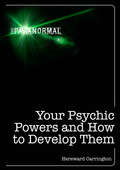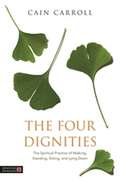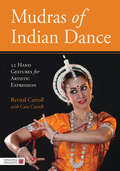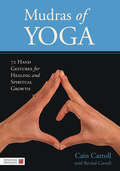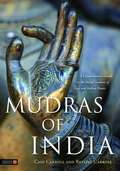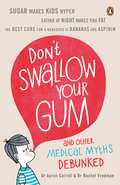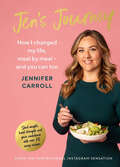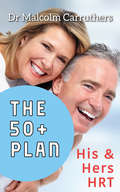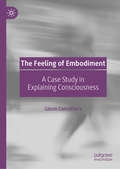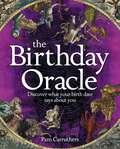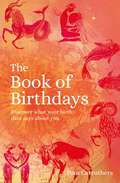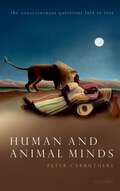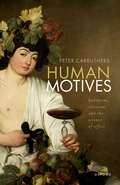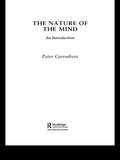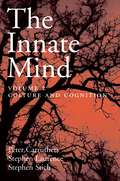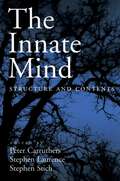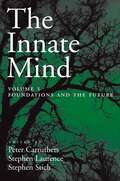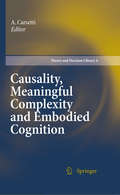- Table View
- List View
Your Psychic Powers and How to Develop Them (The Paranormal)
by Hereward CarringtonThis fascinating book, long a classic in the fields of psychic phenomena and spiritualism, speaks directly to today’s awakened interest in the occult. It contains clear, practical instructions for utilizing and developing the incredible psychic powers latent in all of us.The author claims that with practice, study and discipline, anyone can become a medium and learn to bridge the gap between the Known and the Unknown. He tells you how to create the proper conditions for mediumship, what to expect and how to handle spiritistic phenomena as they occur. He shows you how to banish fear and how to utilize your subconscious mind effectively; he discusses the Spirit World and its inhabitants, the Three Laws of Success, psychometry, the human aura, telepathy, dreams, automatic writing, crystal-gazing, prophecy, reincarnation, meditation and astral projection. These and many other related subjects are full examined and explained in this intriguing and challenging book by one of the foremost pioneers in psychic research.The Paranormal, the new ebook series from F&W Media International Ltd, resurrecting rare titles, classic publications and out-of-print texts, as well as new ebook titles on the supernatural-other-worldly books for the digital age. The series includes a range of paranormal subjects from angels, fairies and UFOs to near-death experiences, vampires, ghosts and witchcraft.
The Four Dignities: The Spiritual Practice of Walking, Standing, Sitting, and Lying Down
by Cain CarrollOffering a fresh perspective on immediate presence and embodied spiritual practice, The Four Dignities shows how the mindful cultivation of the four essential postures - walking, standing, sitting, and lying down - are the basis for a formal practice to develop greater vitality and spiritual awakening. The author reveals the subtle inner nuances of the four traditional meditations, and shows how they can be practiced as a unified system. Readers are given a profound understanding of correct posture, alignment, breathing, and attention, and the author explains the philosophical basis for the practice, offering a pathway toward realizing profound spiritual and energetic transformation. This accessible yet profound study will be an invaluable resource for students and practitioners of yoga, taiji, qigong, and meditation, as well as spiritual seekers, and anyone interested in Eastern philosophy or the study of movement.
The Four Dignities: The Spiritual Practice of Walking, Standing, Sitting, and Lying Down (PDF)
by Cain CarrollOffering a fresh perspective on immediate presence and embodied spiritual practice, The Four Dignities shows how the mindful cultivation of the four essential postures – walking, standing, sitting, and lying down – are the basis for a formal practice to develop greater vitality and spiritual awakening. The author reveals the subtle inner nuances of the four traditional meditations, and shows how they can be practiced as a unified system. Readers are given a profound understanding of correct posture, alignment, breathing, and attention, and the author explains the philosophical basis for the practice, offering a pathway toward realizing profound spiritual and energetic transformation. This accessible yet profound study will be an invaluable resource for students and practitioners of yoga, taiji, qigong, and meditation, as well as spiritual seekers, and anyone interested in Eastern philosophy or the study of movement.
Mudras of Indian Dance: 52 Hand Gestures for Artistic Expression (PDF)
by Cain Carroll Revital CarrollDrawn from two of the most important ancient texts on the subject, the Natya Shastra and the Abhinaya Darpana, this attractive set of user-friendly cards shows the 52 fundamental hand mudras used in Indian dance and theatre. These gestures provide the basis for an entire language of hand articulation. Each card presents a full-colour image of the mudra with Sanskrit name, transliteration and English translation, as well as concise information on origins and applications. The cards are arranged in the traditional order with 28 single-hand and 24 joined-hand gestures, as described in the Abhinaya Darpana. From storytelling to representations of human emotion to spiritual symbolism, hand mudras are one of the most potent and expressive features of Classical Indian Dance. This card set will enrich the practice of students and teachers of Classical Indian Dance and theatre, and will be invaluable to anyone interested in Indian mudras. This eBook is best viewed on a colour device.
Mudras of Yoga: 72 Hand Gestures for Healing and Spiritual Growth (PDF)
by Cain Carroll Revital CarrollHand mudras have been used for centuries in yogic traditions to promote health and wellbeing, and they are considered valuable tools on the path of spiritual awakening. This card set provides 72 of the most important hand mudras used in yoga. The gestures presented support mental and spiritual development, and have a wide range of health benefits. Each card presents a full-colour image of the mudra with the Sanskrit name, transliteration and English translation. The back of each card includes concise information on technique and applications as well as the physical, energetic and spiritual benefits of the mudra. The accompanying booklet contains background information on the mudras, how to practice them at home, and details on how each of the 72 mudras can be used to address a variety of common health complaints. This card set will enrich the practice of students and teachers of yoga, and will be of interest to anyone looking to gain a comprehensive understanding of hand mudras.
Mudras of India: A Comprehensive Guide to the Hand Gestures of Yoga and Indian Dance (PDF)
by Cain Carroll David Frawley Revital CarrollFor thousands of years hand mudras have been used in India for healing, storytelling, emotional expression, and to evoke and convey elevated spiritual states. For the first time, the elaborate system of mudras-as applied in yoga and Indian dance-has been organized into a comprehensive, fully-indexed and cross-referenced format that allows readers access to this still esoteric body of knowledge. Mudras of India presents over 200 photographed hand mudras each with detailed instructions on technique, application, health and spiritual benefits and historical background. The authors have extensively researched the usage of mudras and their significance in the larger context of Indian spiritual systems, and taken painstaking efforts to ensure each mudra is rendered with correct Sanskrit name, transliteration and translation to English. The book will appeal to spiritual seekers, students and teachers of yoga and Indian Dance, scholars and lay people, and anyone interested in the rich cultural heritage of Indian mudras, and the transformative effects of these powerful hand gestures.
Don't Swallow Your Gum: And Other Medical Myths Debunked
by Dr Aaron Carroll Dr Rachel VreemanMen with big feet have big penisesYou should drink at least eight glasses of water a daySugar makes kids hyperEating at night makes you fatChewing gum stays in your stomach for seven yearsYou lose 40% of your body heat through your headEvery day, you hear or think things about your body and health that are just not true. Maybe you saw them on TV, read them in magazines or heard them from friends (or even a doctor). This book is for anyone who has wondered about the truth behind these myths.Funny, wacky and full of fascinating facts, Don't Swallow Your Gum explains why so many of those weird and worrisome things we think about our bodies are mistaken.
Jen's Journey: How I changed my life meal by meal - and you can too
by Jennifer CarrollAfter years of emotional eating, made worse by a bad relationship, Jennifer Carroll weighed almost 26 stone. When her son was born, she made the decision to leave the abusive situation, move home and drastically overhaul her lifestyle.By changing her eating habits and working with a personal trainer, she lost 12 stone. As she got stronger physically and mentally, every part of her life improved.In this book, Jen shares her remarkable story and describes how she overcame her struggles with emotional eating and learned to love exercise. Included are over 75 calorie-counted recipes that are simple, quick to make and packed with flavour, to fill you up while helping you to reach your goals, one meal at a time
Mudras of Indian Dance: 52 Hand Gestures for Artistic Expression
by Revital Carroll Cain CarrollDrawn from two of the most important ancient texts on the subject, the Natya Shastra and the Abhinaya Darpana, this attractive set of user-friendly cards shows the 52 fundamental hand mudras used in Indian dance and theatre. These gestures provide the basis for an entire language of hand articulation. Each card presents a full-colour image of the mudra with Sanskrit name, transliteration and English translation, as well as concise information on origins and applications. The cards are arranged in the traditional order with 28 single-hand and 24 joined-hand gestures, as described in the Abhinaya Darpana. From storytelling to representations of human emotion to spiritual symbolism, hand mudras are one of the most potent and expressive features of Classical Indian Dance. This card set will enrich the practice of students and teachers of Classical Indian Dance and theatre, and will be invaluable to anyone interested in Indian mudras. This eBook is best viewed on a colour device.
Mudras of Yoga: 72 Hand Gestures for Healing and Spiritual Growth
by Revital Carroll Cain CarrollHand mudras have been used for centuries in yogic traditions to promote health and wellbeing, and they are considered valuable tools on the path of spiritual awakening. This card set provides 72 of the most important hand mudras used in yoga. The gestures presented support mental and spiritual development, and have a wide range of health benefits. Each card presents a full-colour image of the mudra with the Sanskrit name, transliteration and English translation. The back of each card includes concise information on technique and applications as well as the physical, energetic and spiritual benefits of the mudra. The accompanying booklet contains background information on the mudras, how to practice them at home, and details on how each of the 72 mudras can be used to address a variety of common health complaints. This card set will enrich the practice of students and teachers of yoga, and will be of interest to anyone looking to gain a comprehensive understanding of hand mudras.
Mudras of India: A Comprehensive Guide to the Hand Gestures of Yoga and Indian Dance
by Revital Carroll Cain Carroll David FrawleyFor thousands of years hand mudras have been used in India for healing, storytelling, emotional expression, and to evoke and convey elevated spiritual states. For the first time, the elaborate system of mudras-as applied in yoga and Indian dance-has been organized into a comprehensive, fully-indexed and cross-referenced format that allows readers access to this still esoteric body of knowledge. Mudras of India presents over 200 photographed hand mudras each with detailed instructions on technique, application, health and spiritual benefits and historical background. The authors have extensively researched the usage of mudras and their significance in the larger context of Indian spiritual systems, and taken painstaking efforts to ensure each mudra is rendered with correct Sanskrit name, transliteration and translation to English. The book will appeal to spiritual seekers, students and teachers of yoga and Indian Dance, scholars and lay people, and anyone interested in the rich cultural heritage of Indian mudras, and the transformative effects of these powerful hand gestures.
The 50+ Plan: His & Hers HRT
by Dr Malcolm CarruthersThe 50+ Plan – His and Hers HRT is an exciting new approach to preventive medicine using pioneering Hormonal Healthcare, designed for both women and men. Based on Dr Malcolm Carruthers’s thirty years of research and clinical experience, The 50+ Plan reveals the extraordinary health benefits of starting on hormone treatment around the age of fifty, in order to promote health and well-being throughout the second half of life. As we live longer the need to reinvigorate our later decades has never been more important. All evidence suggests that estrogen for women and testosterone for men are safest and most beneficial when given for the first time at the age of fifty – the window of opportunity – then continuously and long-term. HRT for both sexes helps to maintain all the systems of the body and can prevent or at least slow down many of the degenerative changes associated with ageing. Heart and circulatory problems are reduced, diabetes prevented, memory maintained and sex life revitalized thanks to HRT. Perhaps most importantly, muscle mass and bone strength are maintained, preventing the osteoporotic fractures in both sexes which can make later life a misery. The 50+ Plan – His and Hers HRT by Dr Malcolm Carruthers is an enlightening guide to ageing with confidence.
The Feeling of Embodiment: A Case Study in Explaining Consciousness
by Glenn CarruthersThis book proposes a novel and rigorous explanation of consciousness. It argues that the study of an aspect of our self-consciousness known as the ‘feeling of embodiment’ teaches us that there are two distinct phenomena to be targeted by an explanation of consciousness. First is an explanation of the phenomenal qualities – 'what it is like' – of the experience; and second is the subject's awareness of those qualities. Glenn Carruthers explores the phenomenal qualities of the feeling of embodiment using the tools of quality spaces, as well as the subject's awareness of those qualities as a functionally emergent property of various kinds of processing of these spaces. Where much recent work on consciousness focuses on visual experience, this book rather draws evidence from the study of self-consciousness. Carruthers argues that in light of recent methodological discoveries, awareness must be explained in terms of the organization of multiple cognitive processes. The book offers an explanation of anomalous body representations and, from that, poses a more general theory of consciousness. Ultimately this book creates a hybrid account of consciousness that explains phenomenology and awareness using different tools. It will be of great interest to all scholars of psychology and philosophy as well as anyone interested in exploring the intricacies of how we experience our bodies, what we are and how we fit into the world.
The Birthday Oracle: Discover Everything that Your Birth Date Says about You
by Pam CarruthersAll of us have wondered what our birth date says about us, and now The Birthday Oracle can reveal its full significance. With a reading for every day of the year, this fascinating book combines astrological expertise with numerology and tarot to reveal your personality profile and identify your strengths and weaknesses. Consult The Birthday Oracle for insight and direction in all areas of your life: Love and relationships Work and career Friends and social life Personal development Meditation
The Book of Birthdays: Discover the secret meaning of your birthdate
by Pam CarruthersAll of us have wondered what our birth date says about us, and now The Book of Birthdays can reveal its full significance.With a reading for every day of the year, this fascinating book combines astrological expertise with numerology and tarot to reveal your personality profile and identify your strengths and weaknesses. Consult The Birthday Oracle for insight and direction in your work and career, love and relationships, social life and more! You will not only learn a lot about yourself but also the characteristics of many of your colleagues, friends and family.Includes:• Strengths and weaknesses• Planets you are governed by• Associated tarot card• Quote to live by• Celebrities and figures born on this day• Meditation to bring out the best in you• A breakdown of your star sign
Human and Animal Minds: The Consciousness Questions Laid to Rest
by Peter CarruthersThe continuities between human and animal minds are increasingly well understood. This has led many people to make claims about consciousness in animals, which has often been taken to be crucial for their moral standing. Peter Carruthers argues compellingly that there is no fact of the matter to be discovered, and that the question of animal consciousness is of no scientific or ethical significance. Carruthers offers solutions to two related puzzles. The first is about the place of phenomenal—or felt—consciousness in the natural order. Consciousness is shown to comprise fine-grained nonconceptual contents that are "globally broadcast" to a wide range of cognitive systems for reasoning, decision-making, and verbal report. Moreover, the so-called "hard" problem of consciousness results merely from the distinctive first-person concepts we can use when thinking about such contents. No special non-physical properties—no so-called "qualia"—are involved. The second puzzle concerns the distribution of phenomenal consciousness across the animal kingdom. Carruthers shows that there is actually no fact of the matter, because thoughts about consciousness in other creatures require us to project our first-person concepts into their minds; but such projections fail to result in determinate truth-conditions when those minds are significantly unlike our own. This upshot, however, doesn't matter. It doesn't matter for science, because no additional property enters the world as one transitions from creatures that are definitely incapable of phenomenal consciousness to those that definitely are (namely, ourselves). And on many views it doesn't matter for ethics, either, since concern for animals can be grounded in sympathy, which requires only third-person understanding of the desires and emotions of the animals in question, rather than in first-person empathy.
Human and Animal Minds: The Consciousness Questions Laid to Rest
by Peter CarruthersThe continuities between human and animal minds are increasingly well understood. This has led many people to make claims about consciousness in animals, which has often been taken to be crucial for their moral standing. Peter Carruthers argues compellingly that there is no fact of the matter to be discovered, and that the question of animal consciousness is of no scientific or ethical significance. Carruthers offers solutions to two related puzzles. The first is about the place of phenomenal—or felt—consciousness in the natural order. Consciousness is shown to comprise fine-grained nonconceptual contents that are "globally broadcast" to a wide range of cognitive systems for reasoning, decision-making, and verbal report. Moreover, the so-called "hard" problem of consciousness results merely from the distinctive first-person concepts we can use when thinking about such contents. No special non-physical properties—no so-called "qualia"—are involved. The second puzzle concerns the distribution of phenomenal consciousness across the animal kingdom. Carruthers shows that there is actually no fact of the matter, because thoughts about consciousness in other creatures require us to project our first-person concepts into their minds; but such projections fail to result in determinate truth-conditions when those minds are significantly unlike our own. This upshot, however, doesn't matter. It doesn't matter for science, because no additional property enters the world as one transitions from creatures that are definitely incapable of phenomenal consciousness to those that definitely are (namely, ourselves). And on many views it doesn't matter for ethics, either, since concern for animals can be grounded in sympathy, which requires only third-person understanding of the desires and emotions of the animals in question, rather than in first-person empathy.
Human Motives: Hedonism, Altruism, and the Science of Affect
by Peter CarruthersMotivational hedonism (often called “psychological hedonism”) claims that everything we do is done in pursuit of pleasure (in the widest sense) and to avoid pain and displeasure (again, in the widest sense). Although perennially attractive, many philosophers and experimental psychologists have claimed to refute it. Human Motives shows how decision-science and the recent science of affect can be used to construct a form of motivational hedonism that evades all previous critiques. On this view, we take decisions by anticipating and responding affectively to the alternatives, with the pleasure / displeasure component of affect constituting the common currency of decision-making. But we do not have to believe that the alternatives will bring us pleasure or displeasure in the future. Rather, those feelings get bound into and become parts of the future-directed representation of the options, rendering the latter attractive or repulsive. Much then depends on what pleasure and displeasure really are. If they are intrinsically good or bad properties of experience, for example, then motivational hedonism results. Carruthers argues, in contrast, that the best account is a representational one: pleasure represents its object (nonconceptually, in a perception-like manner) as good, and displeasure represents it (nonconceptually) as bad. The result is pluralism about human motivation, making room for both genuine altruism and intrinsic motives of duty. Clearly written and deeply scientifically informed, Human Motives has implications for many areas of philosophy and cognitive science, and will be of interest to anyone wanting to understand the foundations of human motivation.
Human Motives: Hedonism, Altruism, and the Science of Affect
by Peter CarruthersMotivational hedonism (often called “psychological hedonism”) claims that everything we do is done in pursuit of pleasure (in the widest sense) and to avoid pain and displeasure (again, in the widest sense). Although perennially attractive, many philosophers and experimental psychologists have claimed to refute it. Human Motives shows how decision-science and the recent science of affect can be used to construct a form of motivational hedonism that evades all previous critiques. On this view, we take decisions by anticipating and responding affectively to the alternatives, with the pleasure / displeasure component of affect constituting the common currency of decision-making. But we do not have to believe that the alternatives will bring us pleasure or displeasure in the future. Rather, those feelings get bound into and become parts of the future-directed representation of the options, rendering the latter attractive or repulsive. Much then depends on what pleasure and displeasure really are. If they are intrinsically good or bad properties of experience, for example, then motivational hedonism results. Carruthers argues, in contrast, that the best account is a representational one: pleasure represents its object (nonconceptually, in a perception-like manner) as good, and displeasure represents it (nonconceptually) as bad. The result is pluralism about human motivation, making room for both genuine altruism and intrinsic motives of duty. Clearly written and deeply scientifically informed, Human Motives has implications for many areas of philosophy and cognitive science, and will be of interest to anyone wanting to understand the foundations of human motivation.
The Nature of the Mind: An Introduction
by Peter CarruthersThe Nature of the Mind is a comprehensive and lucid introduction to major themes in the philosophy of mind. It carefully explores the conflicting positions that have arisen within the debate and locates the arguments within their context. It is designed for newcomers to the subject and assumes no previous knowledge of the philosophy of mind. Clearly written and rigorously presented, this book is ideal for use in undergraduate courses in the philosophy of mind.Main topics covered include:* the problem of other minds* the dualist/physicalist debate* the nature of personal identity and survival* mental-state conceptsThe book closes with a number of pointers towards more advanced work in the subject. Study questions and suggestions for further reading are provided at the end of each chapter.The Nature of the Mind is based on Peter Carruthers' book, Introducing Persons, also published by Routledge (1986).
The Nature of the Mind: An Introduction
by Peter CarruthersThe Nature of the Mind is a comprehensive and lucid introduction to major themes in the philosophy of mind. It carefully explores the conflicting positions that have arisen within the debate and locates the arguments within their context. It is designed for newcomers to the subject and assumes no previous knowledge of the philosophy of mind. Clearly written and rigorously presented, this book is ideal for use in undergraduate courses in the philosophy of mind.Main topics covered include:* the problem of other minds* the dualist/physicalist debate* the nature of personal identity and survival* mental-state conceptsThe book closes with a number of pointers towards more advanced work in the subject. Study questions and suggestions for further reading are provided at the end of each chapter.The Nature of the Mind is based on Peter Carruthers' book, Introducing Persons, also published by Routledge (1986).
The Innate Mind: Volume 2: Culture and Cognition (Evolution and Cognition)
by Peter Carruthers Stephen Laurence Stephen StichThis is the second volume of a projected three-volume set on the subject of innateness. The volume is highly interdisciplinary, and addresses such question as: To what extent are mature cognitive capacities a reflection of particular cultures and to what extent are they a product of innate elements? How do innate elements interact with culture to achieve mature cognitive capacities? How do minds generate and shape cultures? How are cultures processed by minds? The volume will be of great importance to anyone interested in the interplay between culture and the innate mind.
The Innate Mind: Structure and Contents (Evolution and Cognition)
by Peter Carruthers Stephen Laurence Stephen StichThis is the first volume of a projected three-volume set on the subject of innateness. The extent to which the mind is innate is one of the central questions in the human sciences, with important implications for many surrounding debates. By bringing together the top nativist scholars in philosophy, psychology, and allied disciplines these volumes provide a comprehensive assessment of nativist thought and a definitive reference point for future nativist inquiry. The Innate Mind: Structure and Content, concerns the fundamental architecture of the mind, addressing such question as: What capacities, processes, representations, biases, and connections are innate? How do these innate elements feed into a story about the development of our mature cognitive capacities, and which of them are shared with other members of the animal kingdom? The editors have provided an introduction giving some of the background to debates about innateness and introducing each of the subsequent essays, as well as a consolidated bibliography that will be a valuable reference resource for all those interested in this area. The volume will be of great importance to all researchers and students interested in the fundamental nature and powers of the human mind. Together, the three volumes in the series will provide the most intensive and richly cross-disciplinary investigation of nativism ever undertaken. They point the way toward a synthesis of nativist work that promises to provide a new understanding of our minds and their place in the natural order.
The Innate Mind: Volume 3: Foundations and the Future (Evolution and Cognition)
by Peter Carruthers Stephen Laurence Stephen StichThis is the third volume of a three-volume set on The Innate Mind. The extent to which cognitive structures, processes, and contents are innate is one of the central questions concerning the nature of the mind, with important implications for debates throughout the human sciences. By bringing together the top nativist scholars in philosophy, psychology, and allied disciplines these volumes provide a comprehensive assessment of nativist thought and a definitive reference point for future nativist inquiry. The Innate Mind: Volume 3: Foundations and the Future, concerns a variety of foundational issues as well as questions about the direction of future nativist research. It addresses such questions as: What is innateness? Is it a confused notion? What is at stake in debates between nativists and empiricists? What is the relationship between genes and innateness? How do innate structures and learned information interact to produce adult forms of cognition, e.g. about number, and how does such learning take place? What innate abilities underlie the creative aspect of language, and of creative cognition generally? What are the innate foundations of human motivation, and of human moral cognition? In the course of their discussions, many of the contributors pose the question (whether explicitly or implicitly): Where next for nativist research? Together, these three volumes provide the most intensive and richly cross-disciplinary investigation of nativism ever undertaken. They point the way toward a synthesis of nativist work that promises to provide a powerful picture of our minds and their place in the natural order.
Causality, Meaningful Complexity and Embodied Cognition (Theory and Decision Library A: #46)
by A. CarsettiArturo Carsetti According to molecular Biology, true invariance (life) can exist only within the framework of ongoing autonomous morphogenesis and vice versa. With respect to this secret dialectics, life and cognition appear as indissolubly interlinked. In this sense, for instance, the inner articulation of conceptual spaces appears to be linked to an inner functional development based on a continuous activity of selection and “anchorage” realised on semantic grounds. It is the work of “invention” and g- eration (in invariance), linked with the “rooting” of meaning, which determines the evolution, the leaps and punctuated equilibria, the conditions related to the unfo- ing of new modalities of invariance, an invariance which is never simple repetition and which springs on each occasion through deep-level processes of renewal and recovery. The selection perpetrated by meaning reveals its autonomy aboveall in its underpinning, in an objective way, the ongoing choice of these new modalities. As such it is not, then, concerned only with the game of “possibles”, offering itself as a simple channel for pure chance, but with providing a channel for the articulation of the “ le” in the humus of a semantic (and embodied) net in order to prepare the necessary conditionsfor a continuousrenewal and recoveryof original creativity. In effect, it is this autonomy in inventing new possible modules of incompressibility whichdeterminestheactualemergenceofnew(andtrue)creativity,whichalsotakes place through the “narration” of the effected construction.
